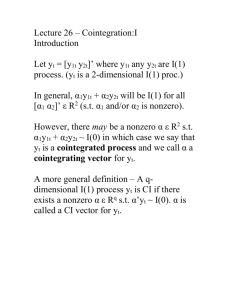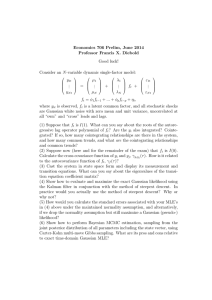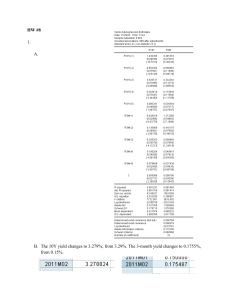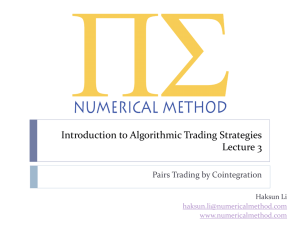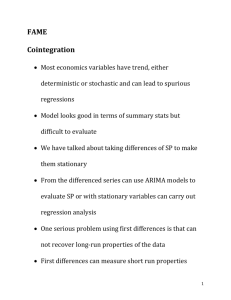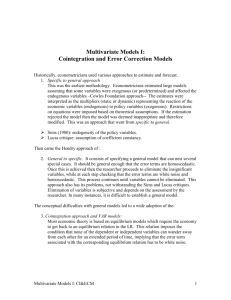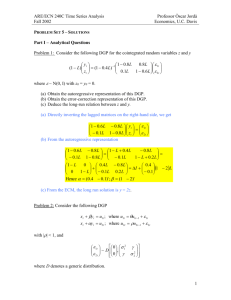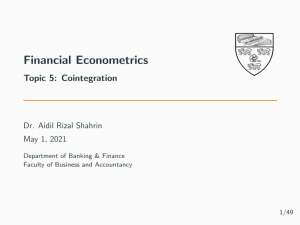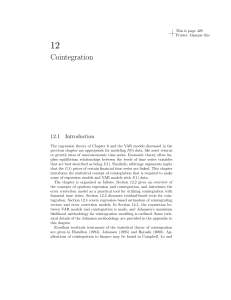Document 13954544
advertisement
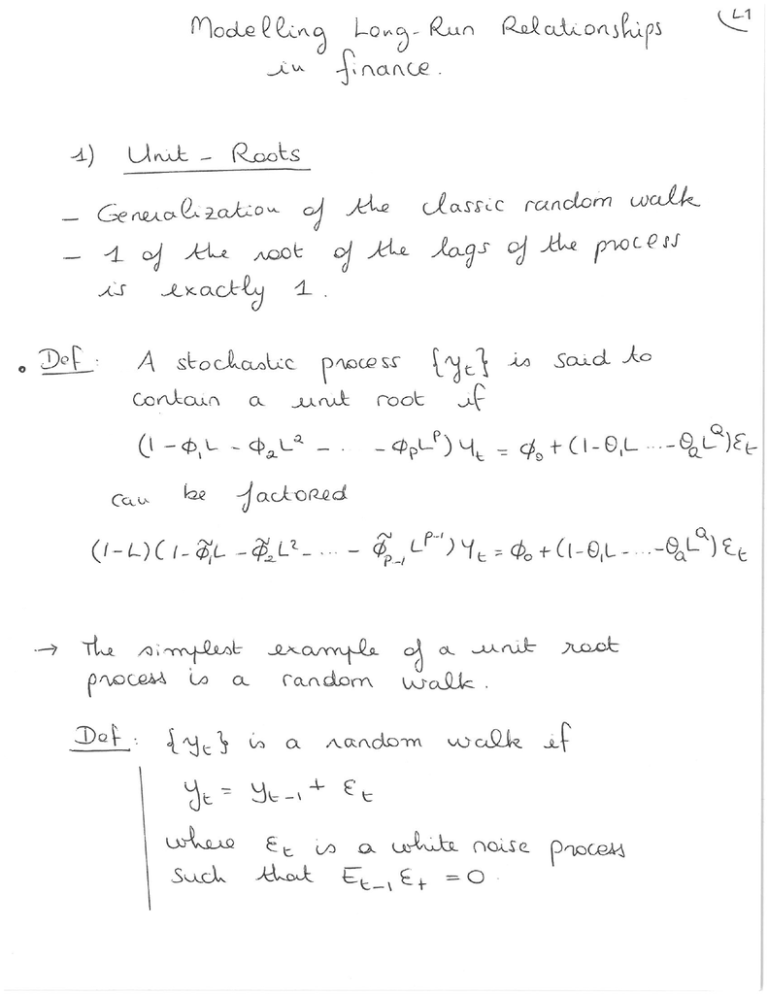
Nonstationary and Stationary VAR(1)s Cointegration (Φ11 ) Independent Unit Roots(Φ12 ) 10 20 8 15 10 6 5 4 0 2 −5 0 −2 0 −10 20 40 60 80 100 −15 0 20 Persistent, Stationary (Φ21 ) 40 60 80 100 Anti-persistent, Stationary(Φ22 ) 6 4 4 3 2 2 1 0 0 −2 −1 −4 −6 0 −2 20 40 60 80 100 −3 0 20 40 60 80 100 A plot of four time-series that all begin at the same point initial value and use the same shocks. All data were generated by yt = Φi j yt −1 + εt where Φi j varies. yt = Φi j yt −1 + εt Φ11 = .8 .2 .2 .8 λi = 1, 0.6 Φ21 = .7 .2 .2 .7 λi = 0.9, 0.5 1 0 Φ12 = 0 1 λi = 1, 1 Φ22 = −.3 .1 .3 −.2 λi = −0.43, −0.06 where λi are the eigenvalues of the parameter matrices. Note that the eigenvalues of the nonsta-tionary processes contain the value 1 while the eigenvalues for the stationary processes are all less than 1 (in absolute value). Also note that the cointegrated process has only 1 eigenvalue which is unity, while the independent unit root process has 2. Higher dimension cointegrated systems may contain between 1 and (k-1) unit eigenvalues. The number of unit eigenvalues indicates the number of unit root "drivers" in a system of equations. The picture presents evidence of another issue in cointegration analysis: it can be very difficult to tell when 2 series are cointegrated. The Mechanics of the ECM: It may not be obvious how a cointegrated VAR is transformed into an ECM. Consider a simple cointegrated bivariate VAR(1) xt yt = .8 .2 .2 .8 x t −1 yt −1 + ε1,t ε2,t To transform this VAR to an ECM, begin by subtracting [x t −1 yt −1 ]0 from both sides xt yt − x t −1 yt −1 ∆x t ∆yt ∆x t ∆yt ∆x t ∆yt = = = = .8 .2 .2 .8 −.2 .2 .8 .2 .2 .8 −.2 .2 1 0 0 1 x t −1 yt −1 x t −1 yt −1 ε1,t ε2,t − .2 −.2 x t −1 yt −1 1 −1 − x t −1 yt −1 + x t −1 yt −1 + + ε1,t ε2,t ε1,t ε2,t + (5.30) ε1,t ε2,t In this example, the speed of adjustment parameters are -.2 for ∆x t and .2 for ∆yt and the normalized (on x t ) cointegrating relationship is [1 − 1]. In the general multivariate case, a cointegrated VAR(P) can be turned into an ECM by recursive substitution. Consider a cointegrated VAR(3), yt = Φ1 yt −1 + Φ2 yt −2 + Φ3 yt −3 + εt This system will be cointegrated if at least one but fewer than k eigenvalues of π = Φ1 +Φ2 +Φ3 − Ik are not zero. To begin the transformation, add and subtract Φ3 yt −2 to the right side yt = Φ1 yt −1 + Φ2 yt −2 + Φ3 yt −2 − Φ3 yt −2 + Φ3 yt −3 + εt = Φ1 yt −1 + Φ2 yt −2 + Φ3 yt −2 − Φ3 ∆yt −2 + εt = Φ1 yt −1 + (Φ2 + Φ3 )yt −2 − Φ3 ∆yt −2 + εt then add and subtract (Φ2 + Φ3 )yt −1 to the right side, yt = Φ1 yt −1 + (Φ2 + Φ3 )yt −1 − (Φ2 + Φ3 )yt −1 + (Φ2 + Φ3 )yt −2 − Φ3 ∆yt −2 + εt = Φ1 yt −1 + (Φ2 + Φ3 )yt −1 − (Φ2 + Φ3 )∆yt −1 − Φ3 ∆yt −2 + εt = (Φ1 + Φ2 + Φ3 )yt −1 − (Φ2 + Φ3 )∆yt −1 − Φ3 ∆yt −2 + εt . Finally, subtract yt −1 from both sides, yt − yt −1 = (Φ1 + Φ2 + Φ3 )yt −1 − yt −1 − (Φ2 + Φ3 )∆yt −1 − Φ3 ∆yt −2 + εt ∆yt = (Φ1 + Φ2 + Φ3 − Ik )yt −1 − (Φ2 + Φ3 )∆yt −1 − Φ3 ∆yt −2 + εt . The final step is to relabel the above equation in terms of π notation, yt − yt −1 = (Φ1 + Φ2 + Φ3 − Ik )yt −1 − (Φ2 + Φ3 )∆yt −1 − Φ3 ∆yt −2 + εt (5.31) ∆yt = πyt −1 + π1 ∆yt −1 + π2 ∆yt −2 + εt . which is equivalent to ∆yt = αβ 0 yt −1 + π1 ∆yt −1 + π2 ∆yt −2 + εt . (5.32) where α contains the speed of adjustment parameters and β contains the cointegrating vectors. This recursion can be used to transform any cointegrated VAR(P) yt −1 = Φ1 yt −1 + Φ2 yt −2 + . . . + ΦP yt −P + εt into its ECM from ∆yt = πyt −1 + π1 ∆yt −1 + π2 ∆yt −2 + . . . + πP −1 ∆yt −P +1 + εt using the identities π = −Ik + PP i =1 Φi and πp = − PP i =p +1 Φi . Cointegrating Vectors: The key to understanding cointegration in systems with 3 or more variables is to note that the matrix which governs the cointegrating relationship, π, can always be decomposed into two matrices, π = αβ 0 where α and β are both k by r matrices where r is the number of cointegrating relationships. For example, suppose the parameter matrix in an ECM was 0.3 0.2 −0.36 π = 0.2 0.5 −0.35 −0.3 −0.3 0.39 The eigenvalues of this matrix are .9758, .2142 and 0. The 0 eigenvalue of π indicates there are two cointegrating relationships since the number of cointegrating relationships is rank(π). Since there are two cointegrating relationships, β can be specified as 1 0 β = 0 1 β1 β2 and α has 6 unknown parameters. αβ 0 can be combined to produce α11 α12 α11 β1 + α12 β2 π = α21 α22 α21 β1 + α22 β2 α31 α32 α31 β1 + α32 β2 and α can be trivially solved using the left block of π. Once α is known, any two of the three remaining elements can be used to solve of β1 and β2 . Appendix A contains a detailed illustration of solving a trivariate cointegrated VAR for the speed of adjustment coefficients and the cointegrating vectors.
